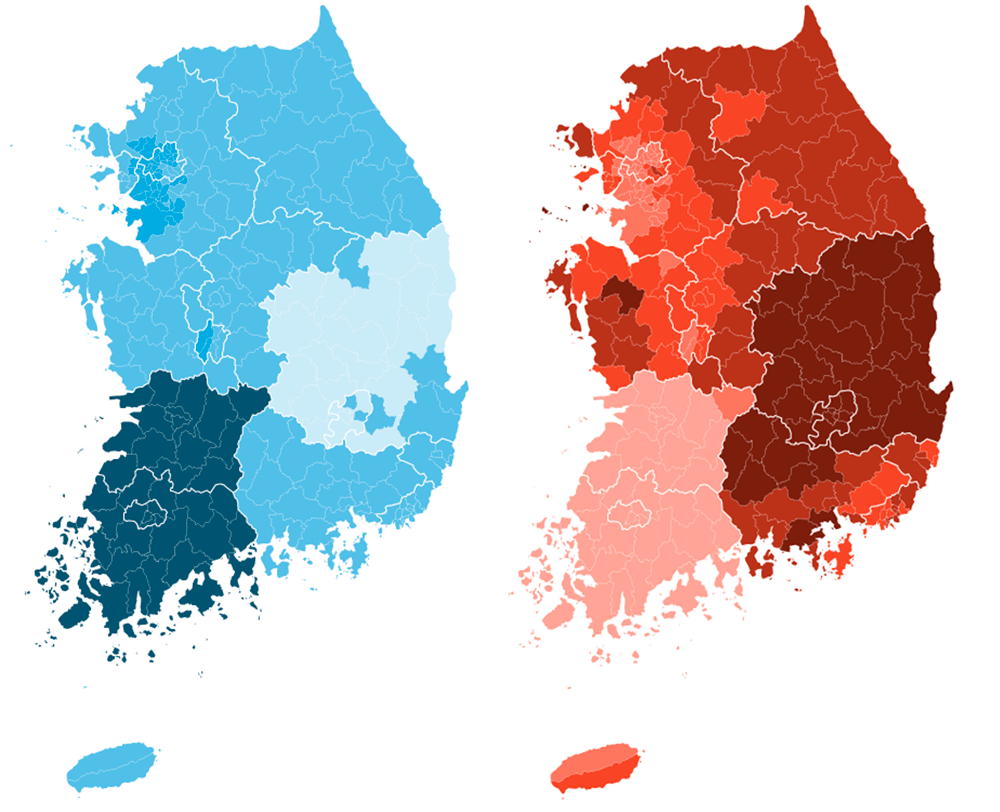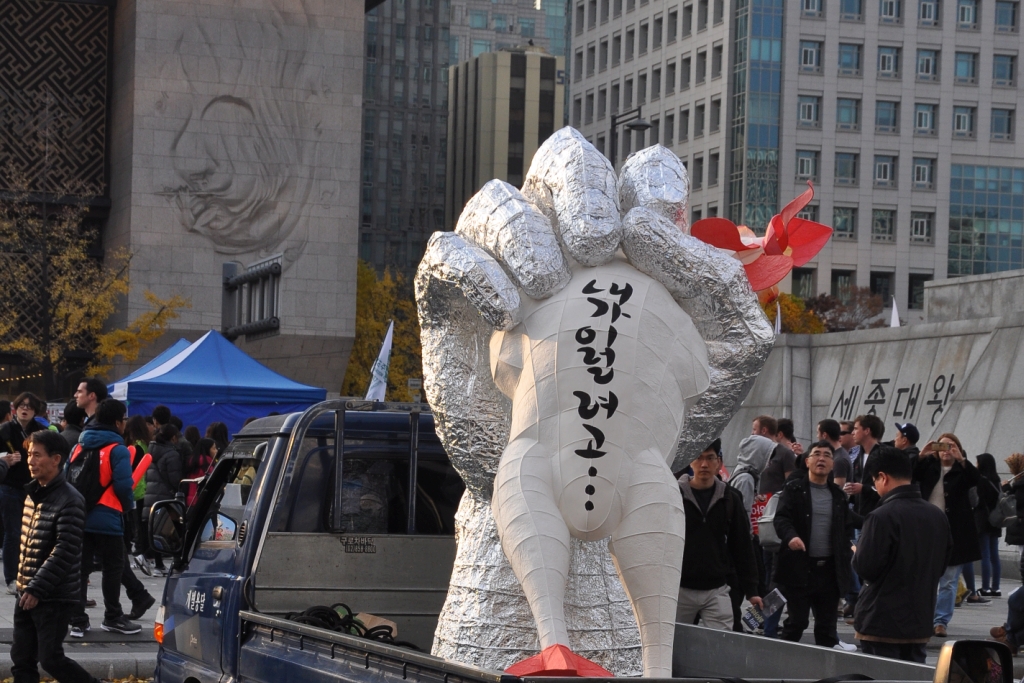
The Potent Force of S Korea's Regionalism
Regionalism remains a potent force in South Korea. “If the U.S. has racism, South Korea has regionalism,” said a 2008 article by wire agency Yonhap. There’s even a special word for regional rivalry: jiyeok gamjeong, which literally means “regional enmity.”
The most historical and emotionally charged regional rivalry may be between the southwest and the southeast: the two Jeolla provinces (also called Honam in Korean) vs. the two Gyeongsang provinces (Yeongnam). Gyeongsang is traditionally a conservative haven; Jeolla is liberal.
Some Jeolla natives call people of Gyeongsang as mundungi (leper), somewhat misleadingly associating the Gyeongsang provinces with leprosy; in fact, leprosaria were historically distributed throughout the southern regions, including parts of Jeolla. There’s “barley-eater,” a somewhat outdated nickname, referring to the times when Gyeongsang was too poor to afford rice. (Jeolla historically was more abundant in rice.)
Gyeongsang’s nicknames for Jeolla are just as endearing. Some in Gyeongsang call those in Jeolla kkaengkkaengi (after the sound of the local dialect, which is said to resemble the whining of dogs). Another disparaging term is hongeo, a fish fermented in its own urine, considered by people in Jeolla as a delicacy there but detested by some outsiders for the smell.
Why do the two regions hate each other? There are a number of theories. One is historical: Jeolla was home to the kingdom of Baekje. Baekje was conquered in the seventh century by the kingdom of Silla, based in what is now Gyeongsang.
Others will bring up the uneven economic development under the military dictatorship of General Park Chung-hee (the father of former president Park Geun-hye). Gyeongsang, where the elder Park came from, was built into a major industrial hub. As a result, Gyeongsang cities like Ulsan, Pohang and Geoje all remain important industrial centers even to this day.
Jeolla, on the other hand, was left to languish as a poor agricultural region, harder for outsiders to access. One of the nation’s earliest and longest highways, the Gyeongbu, was completed under general Park in 1970, linking Seoul to southern Gyeongsang. (Jeolla was left to suffer from poor transportation infrastructure.)
There is also the issue of political history. The rivalry between the elder Park and Kim Dae-jung was as much personal as it was regional. Park was from Gyeongsang; Kim, a long-time dissident who later went on to become the country’s first liberal president (1997-2002), was from Jeolla.
The conservatives’ identity as pro-Gyeongsang became even more fixed in subsequent years; Kim Young-sam, also from Gyeongsang, represented the ruling party in fighting Kim Dae-jung for presidency in 1992. (Kim Young-sam won.) The recently ousted president Park Geun-hye was also from, you guessed it, Gyeongsang.
Traditionally it has been rare for South Korean voters to deviate from their respective tendencies. For example, in the 2012 presidential election, Park Geun-hye received an overwhelming number of votes from Gyeongsang voters. Meanwhile, the vast majority in Jeolla predictably opted for Moon Jae-in.
Thematic maps of the Park-Moon contest — perhaps now familiar to observers of South Korean politics — show this clear regionalism, according to data from the National Election Commission.
In this map, we see Park’s share of the vote, broken down by municipal subdivisions in each province and major city, with darker red shades representing more voter support:
[pym src=”https://mattstiles.org/dailygraphics/graphics/south-korea-election-choropleth-park-20170420/child.html”]
The opposite, of course, is true for Moon. Here darker blue shades represent the areas where his campaign was strongest in that election:
[pym src=”https://mattstiles.org/dailygraphics/graphics/south-korea-election-choropleth-moon-20170420/child.html”]
The maps, obviously, show a wide variance of support for either candidate, depending on the region, as is evident in the broad color scale, which was devised using a common statistical data clustering method known as Jenks.
The vote for Park and Moon, however, was much closer in Seoul. Neither candidate received less than 40 percent of the vote in any district. (Note that the scale for the maps of Seoul, below, also made with Jenks, is different than those depicting the national vote.)
Park was strongest south of the Han River, particularly in Gangnam, where she received just over 60 percent of the vote:
[pym src=”https://mattstiles.org/dailygraphics/graphics/south-korea-seoul-election-choropleth-park-jenks-20170420/child.html”]
And Moon’s strongest district was Gwanak, where he received just under 60 percent:
[pym src=”https://mattstiles.org/dailygraphics/graphics/south-korea-seoul-election-choropleth-moon-jenks-20170420/child.html”]
South Korea’s stark political regionalism is why the parliamentary elections last April were so shocking to some observers. There seemed to be a shift in this voting pattern — not radical, but a shift nevertheless.
The conservatives predictably made a strong showing in Gyeongsang. But in Jeolla, votes were split between the liberal Minjoo Party and the centrist People’s Party, with the latter dominating in Gwangju, the most important and populous city in the region.
South Korean politics is currently at a significant juncture. There are less than two weeks left until election day on May 9. The two leading presidential candidates identify themselves as relatively liberal. Meanwhile, the conservatives are trailing far behind, and unable to unify the splintered factions, which resulted as a consequence of the internal divisions over former president Park Geun-hye.
It’s difficult to say if all these new factions will contribute to changes in South Korea’s regionalism. After all, regional wounds go deep. But we’ll see what happens in two weeks.
The maps have been created and provided by Matt Stiles, a data journalist and Los Angeles Times correspondent based in Seoul. Check out his data stories at The Daily Viz.
Cover image: Regionalism in South Korea. (Source: Matt Stiles/The Daily Viz)
*
Read more on the South Korean presidential elections:

